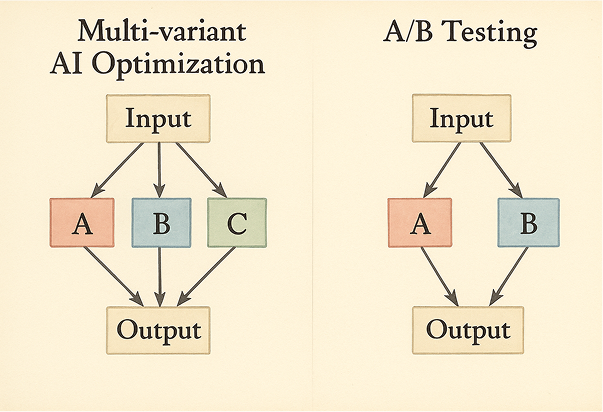Why settle for A/B when you can explore A–Z?
Most digital marketers are familiar with A/B testing: test two versions of a page, measure performance, and pick a winner. It’s simple, intuitive—and deeply limiting.
Today, with AI-native platforms, we’re entering a new era of optimization that moves beyond two-version testing. Multi-variant AI optimization allows users to test multiple designs at the same time like modifying headlines, CTAs, or images to find the most effective combinations. This enables websites to evolve continuously, responding to each visitor, campaign, or even time of day—without human micromanagement.
Here’s how it works.
The Limits of Traditional A/B Testing
A/B testing has powered the CRO industry for over a decade. But it comes with real trade-offs:
- Slow cycles: You need significant traffic and time to reach statistical confidence.
- Small scope: You’re often testing just one variable at a time—like a headline or CTA.
- One-size-fits-all: Everyone gets the same “winning” version, even if it’s not best for them.
This made sense when tools and teams were manual. But today, it’s like navigating with a compass when you have GPS available.
Enter: Multi‑Variant AI Optimization
Instead of pitting two static versions against each other, AI systems can test and adapt thousands of micro-variations in real-time. These aren’t just randomized tests—they’re intelligently generated, targeted, and optimized based on live performance data.
At a high level, here’s how the process works:
1. Generate Multiple Variants—Not Just Two
AI starts with your base content—say, a landing page. It generates multiple variations by adjusting:
- Headlines, CTAs, product descriptions
- Layout, structure, even image selection
- Tone, urgency, or length of messaging
These variants aren’t random. They’re shaped by training data and design principles to remain on-brand and goal-aligned.
2. Serve Variants Dynamically Based on Context
Unlike static tests, AI-driven systems can serve different versions based on real-time factors:
- Ad campaign source or keyword
- User’s location, device, or time of day
- Behavioral signals or past site interactions
This means visitors see the version most likely to resonate with them—before a single test completes.
3. Learn in Real-Time, Not Just Post-Test
Instead of waiting weeks to declare a winner, multi-variant systems adjust continuously. Using techniques like multi-armed bandits and reinforcement learning, they:
- Shift traffic toward high-performing variants
- Explore new possibilities based on partial successes
- Optimize for downstream goals (e.g. revenue, not just clicks)
It’s not just “test and learn”—it’s “test while learning.”
4. Evolve the Experience Over Time
What worked last month may not work today. With multi-variant AI optimization:
- Winning experiences evolve with your audience
- Seasonal or campaign-specific variants surface automatically
- You avoid the dreaded “set it and forget it” CRO trap
This is what makes websites feel alive—constantly tuning to the user and the moment.
Why This Matters Now
We’re in a world of dynamic attention, fragmented channels, and high CACs. Optimization can’t be a once-a-quarter initiative. It has to be built-in, always-on, and adaptive by design.
Multi-variant AI optimization makes that possible—not just for enterprise growth teams, but for any brand that wants more from their traffic.
The Bottom Line
If A/B testing was the calculator of conversion optimization, multi-variant AI is the modern computer. It’s faster, smarter, and always learning.
And in a world where every click counts, that difference can be transformative.

Leave a Reply